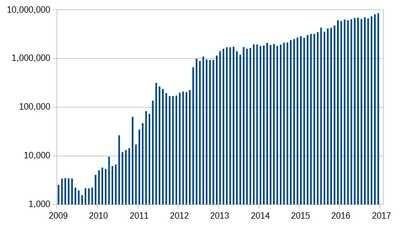Bitcoin History
Bitcoin
is a cryptocurrency, a digital asset designed to work as a medium of exchange that uses cryptography to control its creation and management, rather than relying on central authorities. The presumed pseudonymous Satoshi Nakamoto integrated many existing ideas from the cypherpunk community when creating bitcoin. Over the course of bitcoin's history, it has undergone rapid growth to become a significant currency both on and offline - from the mid 2010's onward, some businesses on a global scale began accepting bitcoins in addition to standard currencies
Premption history
Prior to the release of bitcoin there were a number of digital cash technologies starting with the issuer based ecash protocols of David Chaum # headerand Stefan Brands. Adam Back developed hashcash, a proof-of-work scheme for spam control. The first proposals for distributed digital scarcity based cryptocurrencies were Wei Dai's b-money and Nick Szabo's bit gold.Hal Finney developed reusable proof of work (RPOW) using hashcash as its proof of work algorithm.
In the bit gold proposal which proposed a collectible market based mechanism for inflation control, Nick Szabo also investigated some additional enabling aspects including a Byzantine fault-tolerant asset registry to store and transfer the chained proof-of-work solutions.
There has been much speculation as to the identity of Satoshi Nakamoto with suspects including Wei Dai, Hal Finney and accompanying denials.The possibility that Satoshi Nakamoto was a computer collective in the European financial sector has also been discussed.
Creation
On 18 August 2008, the domain name bitcoin.org was registered. Later that year on 31 October, a link to a paper authored by Satoshi Nakamoto titled Bitcoin: A Peer-to-Peer Electronic Cash System was posted to a cryptography mailing list. This paper detailed methods of using a peer-to-peer network to generate what was described as "a system for electronic transactions without relying on trust".In January 2009, the bitcoin network came into existence with the release of the first open source bitcoin client and the issuance of the first bitcoins, with Satoshi Nakamoto mining the first block of bitcoins ever (known as the genesis block), which had a reward of 50 bitcoins. Embedded in the coinbase of this block was the text:
The Times 03/Jan/2009 Chancellor on brink of second bailout for banks.
Growth
2011
Based on bitcoin's open source code, other cryptocurrencies started to emerge.
The Electronic Frontier Foundation, a non-profit group, started accepting bitcoins in January 2011, then stopped accepting them in June 2011, citing concerns about a lack of legal precedent about new currency systems. The EFF's decision was reversed on 17 May 2013 when they resumed accepting bitcoin.
In June 2011 Wikileaks and other organizations began to accept bitcoins for donations.
On 22 March 2011 WeUseCoins published the first viral video which has had over 6.4 million views. In September 2011 Vitalik Buterin co-founded Bitcoin Magazine. On 23 December 2011, Douglas Feigelson of BitBills filed a patent application for "Creating And Using Digital Currency" with the United States Patent and Trademark Office, an action which was contested based on prior art in June 2013.
2012
In January 2012, bitcoin was featured as the main subject within a fictionalized trial on the CBS legal drama The Good Wife in the third-season episode "Bitcoin for Dummies". The host of CNBC's Mad Money, Jim Cramer, played himself in a courtroom scene where he testifies that he doesn't consider bitcoin a true currency, saying "There's no central bank to regulate it; it's digital and functions completely peer to peer"
In September 2012, the Bitcoin Foundation was launched to "accelerate the global growth of bitcoin through standardization, protection, and promotion of the open source protocol". The founders were Gavin Andresen, Jon Matonis, Patrick Murck, Charlie Shrem, and Peter Vessenes
In October 2012, BitPay reported having over 1,000 merchants accepting bitcoin under its payment processing service.[38] In November 2012, WordPress had started accepting bitcoins.
2013
In February 2013 the bitcoin-based payment processor Coinbase reported selling US$1 million worth of bitcoins in a single month at over $22 per bitcoin.[40] The Internet Archive announced that it was ready to accept donations as bitcoins and that it intends to give employees the option to receive portions of their salaries in bitcoin currency.
In March the bitcoin transaction log called the blockchain temporarily split into two independent chains with differing rules on how transactions were accepted. For six hours two bitcoin networks operated at the same time, each with its own version of the transaction history. The core developers called for a temporary halt to transactions, sparking a sharp sell-off. Normal operation was restored when the majority of the network downgraded to version 0.7 of the bitcoin software.The Mt. Gox exchange briefly halted bitcoin deposits and the exchange rate briefly dipped by 23% to $37 as the event occurred before recovering to previous level of approximately $48 in the following hours. In the US, the Financial Crimes Enforcement Network (FinCEN) established regulatory guidelines for "decentralized virtual currencies" such as bitcoin, classifying American "bitcoin miners" who sell their generated bitcoins as Money Service Businesses (or MSBs), that may be subject to registration and other legal obligations.
Price and value history


